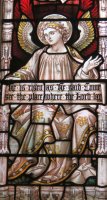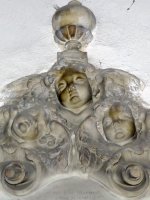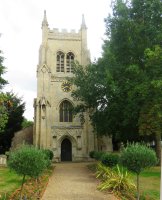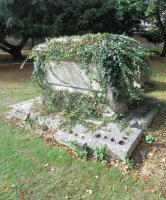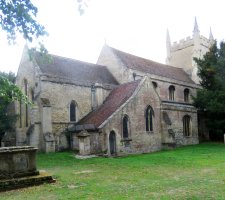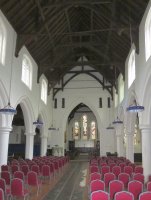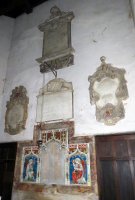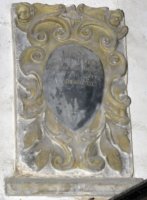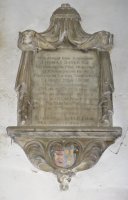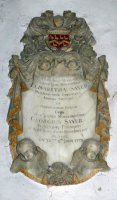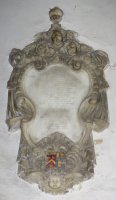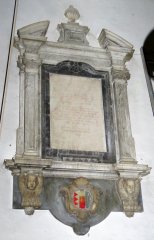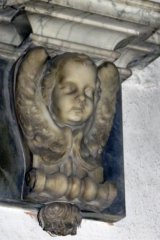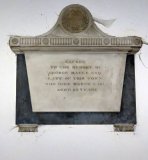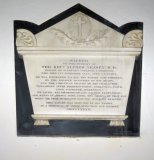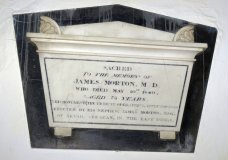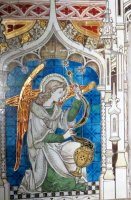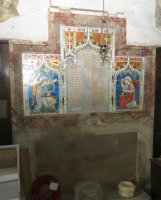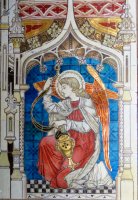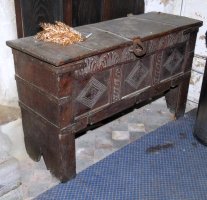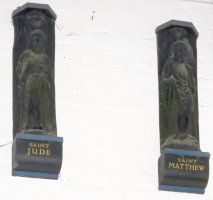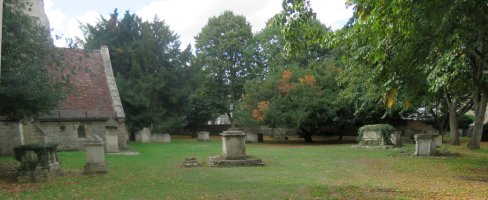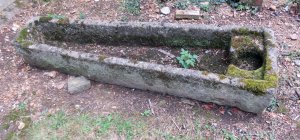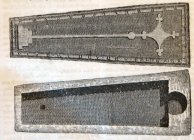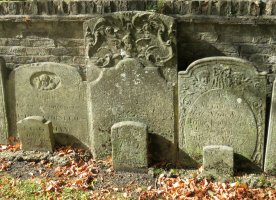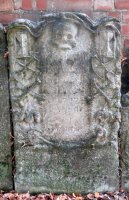St Mary Huntingdon - Monuments
St Mary Huntingdon, Cambridgeshire, is a medieval church containing several 18th and 19th Century monumental panels, including well carved cartouches with winged angel heads, and several pieces signed by their makers. In addition, there is a splendid World War I memorial in Arts and Crafts style, and outside in the Churchyard is an ancient stone coffin.
St Mary Huntingdon.
The Church of St Mary Huntingdon stands just off Huntingdon High Street, set back from the street in its graveyard. It is a medieval building, with a three storey tower with big Gothic buttresses with empty niches, and crocketing at the top - mid-late 15th Century suggests Pevsner. The door case looks older but was recut in Victorian times; again, there are empty niches to the sides. All the rest in the same honey coloured stone, the chancel being rather lower than the nave, which has a clerestory, but with similarly angled roof, and with a variety of heavy buttresses all the way round, rather shorter and more solid than the walls. The most satisfying exterior feature is on the south side, an extra roof rising up looking like it might contain a staircase, but actually containing the vestry and the taller organ chamber..
The mix of different doors and windows, placed somewhat haphazardly, shows that the Church has been through a lot of changes. Aside from very fragmentary 12th Century work, the south aisle and the chancel include a fair amount of 13th Century, including the doorways with their dogtooth ornament and the buttresses at this end - the chancel was actually shortened by one bay. At the other end, the West Tower has a late 14th Century base, and the south porch also dates from this period. Further alterations followed in the 16th and 17th Centuries, including some movement of windows and doors, and building of some of the West Tower which had a partial collapse in 1609. Note too the variety of decayed beasts and heads dotted around the walls, from that time and earlier. That vestry and organ chamber are mid-Victorian - well done to them in terms of atmosphere - along with the three lights window to the Chancel and the architect Reginald Blomfield undertook further restorative work in the 1870s. From outside, it all looks very picturesque.
Inside, mayhap due to Blomfield, there is much less variety, and we see a fairly symmetric structure of nave, pillars to left and right with similar-looking aisles, chancel seen through the arch, and the organ blocking off the extension to the north of the chancel. The dark wooden-beamed roof to the nave is 17th Century, and contrasts nicely with the white walls. The majority of the several panel monuments are clustered in the tower - view of the one side above right (click to enlarge).
Monuments
- Late 17th or early 18th Century panel, which I could not read, with fluted pilasters to the sides, and flanking those, scrolly side-pieces.At the top, entablature, shelf, and broken pediment with a pot. At the base, a gadrooned [corrugated] shelf, under which are carvings of leaves receding to a terminus, and a central cartouce of arms, now blank.
- Late 17th or early 18th C monument: again I could not read it. The panel has a heavy shelf above,
on which rests a broad-topped urn, with carved cascading flowers to each side. At the base, another over-large shelf,
and below, an apron with two cherub heads emerging from twisted drapery.
I would presume these two are the monuments to Sir Nicholas Pedley, d.1685 and John Raby d.1731/32 but not sure which is which, though the first one noted above would be a little old fashioned by the 1730s, so guessing it is Pedley.
John Lovesey monument.
- John Lovesey, d.1707, a single block of pale stone, carved with simple scrolling, two small winged cherub heads at the top corners, and leaves below. The central inscription is on a black teardrop.
- Thomas Sayer, d. 1697, and his wife Elizabeth Sayer, d.1726, with a Latin inscription.
The earliest of a group of grand panel monuments to the Sayer family. The inscribed panel has a carved canopy on top, with drapery
descending from a central dome, sweeping outwards to twist around two small winged cherub heads,
looping behind them to hang in graceful folds to left and right. Below, a heavy shelf,
and then the painted shield of arms with carved branches around it, and a small terminus.
The piece is interesting in being of transitional design between a rectangular panel, and the cartouche style of monument noted below,
while the lower part is something of a throwback to the curved aprons supporting broad shelves of many 17th Century monuments.
Monuments to the Sayer family, 18th Century.
- Elizabeth Sayer, d.1729, erected by her husband George Sayer. An excellently carved cartouche monument, thus a sculptural monument based on a curved shape rather than a rectangular, architectural shape. The inscribed panel, slightly domed like a carapace, is roughly oval, but its shape is rather defined by the complex border, giving a satisfying, sharply cut composition with angles and curves and shadows. Above the inscription are a pair of cherub heads, their wings overlapping, perhaps emblematic of the souls of the wife and husband. Carved drapery over the tops of their heads hangs to the sides, then is pulled up and knotted, tied with tasselled ribbons; the knots give defining top corners to the 'frame'. From these knots, the drapery hangs in drop-folds, with gilt fringes, and we see that this spreads out at the base, so our inscription is actually on the open surface of a carved cloth caught up at the sides. In front of the lower portion are two more winged cherub heads, of larger size, and with flowers in the centre with more tassels. On top of the upper border are the coat of arms, painted on a miniature cartouche, with a knight's crest and extensive mantling around, finished with flowers to fill in the gaps and unite this upper part with the rest of the monument. Super.
- Elizabeth [Lysons] Cacassonnette, d.1749, Sir Edmund Gardner, Knight, and his wife, also
Elizabeth, and Thomas Lysons. Classical panel typical of the more grand monochrome variety
in vogue in the 18th Century. Thus the white inscribed panel is within a black marble border, with a raised upper edge
with a carved scallop shell. To left and right are pilasters - flat pillars, with Corinthian capitals,
and receding outer pilasters. These support a heavy upper portion, being a curved, broken pediment, with a central plinth
supporting a small funereal urn. This sits on a moulded base with blank entablature. Towards the base of the panel,
we have a shelf with more mouldings, coming forward at the sides to support the pilasters, and under those sides,
brackets carved as winged cherub heads, each with a terminus of a flower bud at the base. Between these, on the black,
curved under-panel or apron, is a cartouche of arms, painted, with anther scallop on top. A very well proportioned piece,
by the important 18th Century sculptor Peter Scheemakers.
Scheemakers' monument to Elizabeth Cacassonnette.
- George Sayer, d.1752, with a lengthy Latin inscription. Another cartouche of ornate style. The inscription here is on a central violin-shaped panel, slightly domed, with an ornately carved border of scrolling, hanging drapes and winged cherub heads. Above the inscription are a group of three of these heads, their wings outspread, the centremost one supporting a small urn, the lower ones with tilted faces. To the sides, drapery hangs down from knots carved with much undercutting, with an inner border of scrolling, reminiscent of an unfolding leaf from a Monstera. The drapes hang free at the base, left and right of a painted shield of arms surrounded by mantling, and with the terminus at the base being a further cherub head, wings outstretched. A very good piece, characteristic of the more complex cartouche type. See picture a little up the page, to the right (click to enlarge).
- Revd. Robert Hodson, d.1803, who had many roles, and his wife Mary Hodson, d.1800, erected by their children. Above the white inscribed panel is a shelf, above which is a relief carving of ecclesiastical accoutrements: an open book, a chalice upon a second engraved with the IHS symbol for 'Jesus', closed book, and an embroidered cushion to kneel on. Signed by [Rouw, Sculptor, modeller to His Majesty, New Road, London]. The Rouw brothers, Peter Rouw the Younger and the less prolific Henry Rouw, made a number of monuments in London and southern England.
- Mary Elizabeth Montagu, d.1805, wife of Rear Admiral Robert Montagu, who was a son of the Earl of Sandwich - a later Earl Montagu gave the pulpit to the Church. White tablet carved with a frame with mouldings.
- George Maule, d.1812, white on black panel styled as a tomb chest end (for lots more on white on black monuments, see this page).
The inscribed panel, which has slanted sides has at the top a shelf with mouldings, and an upper curved portion including
a carved wreath within a circle. There is a black backing with vertical sides to the lower portion, bearing little feet.
Signed by Coles, which is the firm of John and James Coles of Huntingdon, active in the Huntingdon area and Northamptonshire.
White on black panels: Maule and Revd. Veasey.
- The Revd. Alfred Veasey, d.1834, erected by his family. Neat casket tablet, thus the inscribed panel and surround cut in the shape of a casket tomb (see the white on black monuments page for other examples of the type). At the top, the lid has a cross surrounded by a sunburst or glory carved in low relief, and crossed branches; to the sides are acroteria ('ears') in an anthemion design (i.e. with curvy stylised petals); at the base, little feet. Crisply cut, and on a shaped black backing, signed by Edward Gaffin, of Gaffins of Regent Street, most prolific of all the white-on-black panel makers.
- Sir John Arundel, Knight, d.1837. Plain tomb chest end, with narrow shelf above, on which sits a bit of marble cut to pediment plus acroteria shape, and two block feet.
- James Morton, d.1840, erected by his nephew James Morton, of Akyab, Arracan, East Indies [which later became Burma, now Myanmar]. Another casket tablet, rather simpler, with the only sculptural decoration being the acroteria - picture below. Signed by Pocock and Glover - they were not statuaries per se, but a local firm of architects, responsible three years later for the Literary and Scientific Institution with its statue of Minerva on Huntingdon High Street (now called the Commemoration Hall - see this page). James Pocock had rebuilt the west gallery for All Saints Church nearby just a few years previously.
- Capt. Frederick Simes Attree, Capt. Charles Anderson, and other officers and men of the Huntingdonshire Regiment who fell at Sevastopol, erected 1857. White on black panel with a curved top, and at the base, a large apron on which is carved drapery - (flags with regimental battles listed) under a helmet and sword. Typical Victorian.
- Agnes Moss-Blundell, d.1931, plain rectangle with border.
- Lt. George Christopher Burder MC, d.1943, killed in action at Heber, Germany. Speckled stone panel, fairly common by this period, with coloured regimental shield.
- Edmund Michael Dear, d.1970, chorister for 50 years. Plain speckled panel with inscribed cross.
There are also a few brass panels. We may note especially that to Corporal Arthur Ayres, Alfred Wiggins and George Eli Brown, who died in the Boer War, 1899-1902 (see picture at top of page). Typical black lettering with initials in red, double border, and, unusually, coloured shields above and below.
And we may note a plainer panel informing us that the reredos was given in memory to Miles Atkinson, d.1894, then Vicar of the parish.
Also in the Church:
World War 1 memorial.
The principal furnishing is the splendid Arts and Crafts style World War 1 memorial, in pinky brown alabaster and incorporating colourful tile pictures, notably a large pair of kneeling angels to the sides, repurposed from a reredos. They are excellently conceived and harmonious in design and composition. She on the left wears a wide-sleeved robe over some long dress of green; her sister on the right has a red garment under an open, sleeved robe. Each carries a censor hanging from long, looping ties, their poses and wings are symmetrically disposed, each with one wing over the back, and each has a halo with gold smalti mosaics. They are within Gothic arches, with pendants, and the floors are medieval style chequering as if in some medieval manuscript. The backing, though, is of a deep blue tiling, a shade as beloved of the Arts and Crafts movement as the gold and the pinky brown alabaster. The detailing is excellent: the faces Pre-Raphaelite, the hair richly curling, the poses of the hands, and the almost Durer-like folding of the drapes all show a sure hand.
For the rest, we may note:
- The font, heavy octagonal, on a great central shaft with surrounding pillars, 13th Century, but whitewashed.
- Wall inscriptions associated with the work on the Church in the 17th Century, most notably to R. Cromwel and I Turpin, Bailiefs [sic] in 1609, and to John Bardolph and Job Bradshaw, Church Wardens in 1698, and with several other names and initials dotted around, including noting the Vicar in 1608, Robert Law. The 'R. Cromwel' noted is Robert Cromwell, father of Oliver Cromwell, baptised in the neighbouring church of All Saints.
- Charity Boards listing donations to the parish, tall and dark.
- High up on the Chancel arch are small carved figures, very dark and difficult to see properly (poor picture below right). They date from 1500. The modern inscriptions name them as St Jude, St Matthew, St Bartholomew and St Stephen, but the accoutrements are not obvious - where for example is Bartholomew's knife.
- wooden furniture, including two chests, the smaller, more decorated one of which could be used as a seat, chairs with twisted rails and a desk with much carving. All from the 17th Century. The Eagle Lectern is also of wood, rather bulky of its type.
- The pulpit, painted stone, with Gothic blind windows around the panelled sides.
- Also good is the late Victorian stained glass, with several serious-looking angels in an effective grisaille style, and a nice triptych of Faith, Hope and Charity to the memory of Edmund Howson, d.1895.
- A couple of small statues of saints, presumably wood, and painted: such things are not meant to be looked at closely, where the bright colours and pious looks come over as too sweet for the modern taste, but seen from a distance. Also gilt angels as candlestick supporters (one pictured above), rather better. Such things were produced anywhere from Victorian times through to after WW1, but these ones are doubtless associated with the altar, 1920, designed by Ninian Comper.
Churchyard:
The Churchyard has been largely cleared in the centre, with trees atmospherically around the sides.
There is a very ancient stone coffin by the side of the tower; there used to be a second, broken one, but I did not see it. The one which remains has a characteristic 'keyhole' shaped interior, and an indent for the lid. Such things are difficult to date, but it could easily be from the 12th Century origins of the Church, or perhaps brought from St Mary's Priory, an establishment of the Austin Canons a little away from the town centre; it could also be of later date, as per the 14th Century example from London of similar shape and size shown in the engraving.
Ancient 'keyhole' coffin.
A variety of tomb chests are dotted around the Churchyard (see view above). These are of 18th and 19th Century dates, and have the typical form of stone sides with inscriptions, and a great flat or slightly angled top, which in some of the flat cases, would have an inscription upon it. There is low relief carving on a couple of these tombs, and a few have lost their side panels so the interior brick construction can be seen.
The headstones have been mostly moved to the side walls of the graveyard, though at least a couple of very typical 18th Century carved headstones remain dotted around, including to Richard Jordan, d.1717, at Hinchingbrook, a mile away to the west, on which can be seen, dimly, the remains of a winged cherub head with scrolly surrounds. Moving gravestones to the walls can either ruin or preserve them, dependent on how exposed they are and the damp, and many of the examples here are moss-covered and decaying. Here we can see a few severely Classical headstones with pilasters to the sides, supporting an entablature. Also Victorian pieces with shaped tops and simple carved devices above the inscriptions - for example crossed branches, drapery, vases, sunbursts, and one with a crossed anchor (denoting loyalty) and cross (faith). One of the most ruined ones appears to have a pair of flying cherubs with clasped hands. The occasional slate headstone by contrast remains crisp and undamaged. There are quite a number of headstones with winged cherub heads, and we can see how they have been adapted stylistically to a range of settings, including paired over a double-panel, or combined with cartouches, or mingled with other scrolling and acanthus leaves. I saw one rather fine 18th Century headstone with a skull, surrounded by memento mori - hour glasses, crossed bones, and the crossed tools of the gravedigger: spade and pickaxe - see picture below (you will need to click to enlarge).
18th Century headstones, and example with gravedigger tools.
Some of the 18th Century and early 19th Century pieces are good of their type, and as a collection give a guide to the styles and compositional rules of space filling ornament of the times; a shame to see them decaying away.
The Church website is at: https://www.huntingdonparish.org/our-churches
Also noted on these pages in Huntingdon: All Saints Church, and a brief page on other things in Huntingdon).
